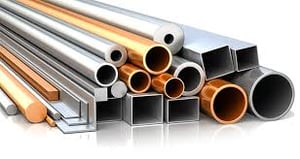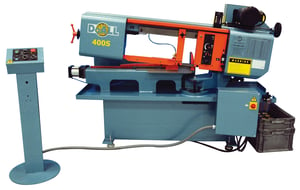Understanding the Process of Sawing is critical to selecting the right process. Whereas Bandsaws utilize a hardened toothed steel band to remove material a Cold Saw a round disc shaped toothed blade.The Bandsaw produces a rougher finish and typical accuracies are not greater than 1/64” on part lengths or squareness whereas the process of cold sawing produces a milled like finish and part accuracy is thereby greatly improved on the order of +/- 0.005” on part length or more. Your specific application will best direct you to the right process.
Material Type: Ferrous Vs. Non-Ferrous
Both processes of Bandsaw and Cold Saws are well suited for Ferrous and Non-Ferrous applications as engineers have  designed them with the proper attributes to be successful at cutting either type of material. Cold Saws run at Low RPMS for cutting materials like Aluminum, Brass, Copper and other Non Ferrous Materials. Other systems are designed to run even at a slower RPM to processes materials like Carbon Steel, Alloy Steels and Stainless Steels. Bandsaws also are quote capable of cutting either materials of the Ferrous or Non-Ferrous variety.
designed them with the proper attributes to be successful at cutting either type of material. Cold Saws run at Low RPMS for cutting materials like Aluminum, Brass, Copper and other Non Ferrous Materials. Other systems are designed to run even at a slower RPM to processes materials like Carbon Steel, Alloy Steels and Stainless Steels. Bandsaws also are quote capable of cutting either materials of the Ferrous or Non-Ferrous variety.
Part/Material Size
Cold Saws are typically lead to an application driven purchase whereas Bandsaws can be a more “catch-all” purpose machine (although there are many types to choose from as we detailed here). As cold saws are limited in diameter to about 6” and under, one could make a quick decision based on size capacity alone. Bandsaws generally provide for a much larger cutting capacity. However if your part blank size is 6” or less a cold saw can be a great option to consider.
Cut Length Accuracy
As previously mentioned, Cold Saws are much more capable of not only holding part length accuracy, but also straightness%20NEW%20DoALL%20SC-75A%20Circular%20Saw%20-%20Pic%203.png?width=300&name=(2091)%20NEW%20DoALL%20SC-75A%20Circular%20Saw%20-%20Pic%203.png) of cut. One of the advantages of the Bandsaw is the flexibility of the bandsaw blades which not only allows the guides to be separated for larger workpieces but is also inherently one of its downfalls. As the band is flexible, it does “wander” throughout the cut and produces a slightly less accurate cut (the wider and stiffer the blade the less pronounced this is). If your simply cutting up material for later turning or machining operations the Bandsaw can be quite efficient, however if you're looking for finished parts right from your saw the Cold Saw can prove itself as the superior choice.
of cut. One of the advantages of the Bandsaw is the flexibility of the bandsaw blades which not only allows the guides to be separated for larger workpieces but is also inherently one of its downfalls. As the band is flexible, it does “wander” throughout the cut and produces a slightly less accurate cut (the wider and stiffer the blade the less pronounced this is). If your simply cutting up material for later turning or machining operations the Bandsaw can be quite efficient, however if you're looking for finished parts right from your saw the Cold Saw can prove itself as the superior choice.
Part Finish
If part finish is a requirement then the cold saw will win in that category every time. A cold saw will provide for a square, accurate cut with a milled like finish. Better part accuracy AND perfectly squared cuts means tight joints and likely eliminate the secondary operation of re-facing or cleaning the cut surface. This is critically important in secondary applications such as (Robotic) welding.

Efficiency
In the long run neither the Cold Saw or the Bandsaw is truly more economical. While initially the price of a Cold Saw blade may be higher than a Bandsaw blade, it's important to remember that a Cold Saw blade can be re-sharpened whereas a Bandsaw blade needs to be discarded once it goes bad. Also the blade change over time is typically much quicker in a Cold Saw then in a Bandsaw.
In summary, if your parts fit into a Cold Saws range AND you need the part accuracy and cut quality, then a Cold Saw can be the right choice. However if you need versatility and a wide range of size capabilities and flexibility you are likely better suited for a quality Bandsawing System.
Do you want to discuss how a Cold Saw or Band Saw can work for your application? Contact the experts at Southern Fabricating Machinery Sales today! Shopping for a Saw? Check out our selection of both Bandsaws and Cold Saws HERE.
Call us directly at 813-444-4555 or visit us on the web at WWW.SOUTHERNFABSALES.COM
Like this post? You’ll also enjoy:
The Different Types of Bandsaws
4 Easy Steps in Selecting the Right Horizontal Bandsaw
The Cold Hard Facts of Cold Saws

 designed them with the proper attributes to be successful at cutting either type of material. Cold Saws run at Low RPMS for cutting materials like Aluminum, Brass, Copper and other Non Ferrous Materials. Other systems are designed to run even at a slower RPM to processes materials like Carbon Steel, Alloy Steels and Stainless Steels. Bandsaws also are quote capable of cutting either materials of the Ferrous or Non-Ferrous variety.
designed them with the proper attributes to be successful at cutting either type of material. Cold Saws run at Low RPMS for cutting materials like Aluminum, Brass, Copper and other Non Ferrous Materials. Other systems are designed to run even at a slower RPM to processes materials like Carbon Steel, Alloy Steels and Stainless Steels. Bandsaws also are quote capable of cutting either materials of the Ferrous or Non-Ferrous variety.%20NEW%20DoALL%20SC-75A%20Circular%20Saw%20-%20Pic%203.png?width=300&name=(2091)%20NEW%20DoALL%20SC-75A%20Circular%20Saw%20-%20Pic%203.png) of cut. One of the advantages of the Bandsaw is the flexibility of the bandsaw blades which not only allows the guides to be separated for larger workpieces but is also inherently one of its downfalls. As the band is flexible, it does “wander” throughout the cut and produces a slightly less accurate cut (the wider and stiffer the blade the less pronounced this is). If your simply cutting up material for later turning or machining operations the Bandsaw can be quite efficient, however if you're looking for finished parts right from your saw the Cold Saw can prove itself as the superior choice.
of cut. One of the advantages of the Bandsaw is the flexibility of the bandsaw blades which not only allows the guides to be separated for larger workpieces but is also inherently one of its downfalls. As the band is flexible, it does “wander” throughout the cut and produces a slightly less accurate cut (the wider and stiffer the blade the less pronounced this is). If your simply cutting up material for later turning or machining operations the Bandsaw can be quite efficient, however if you're looking for finished parts right from your saw the Cold Saw can prove itself as the superior choice.




